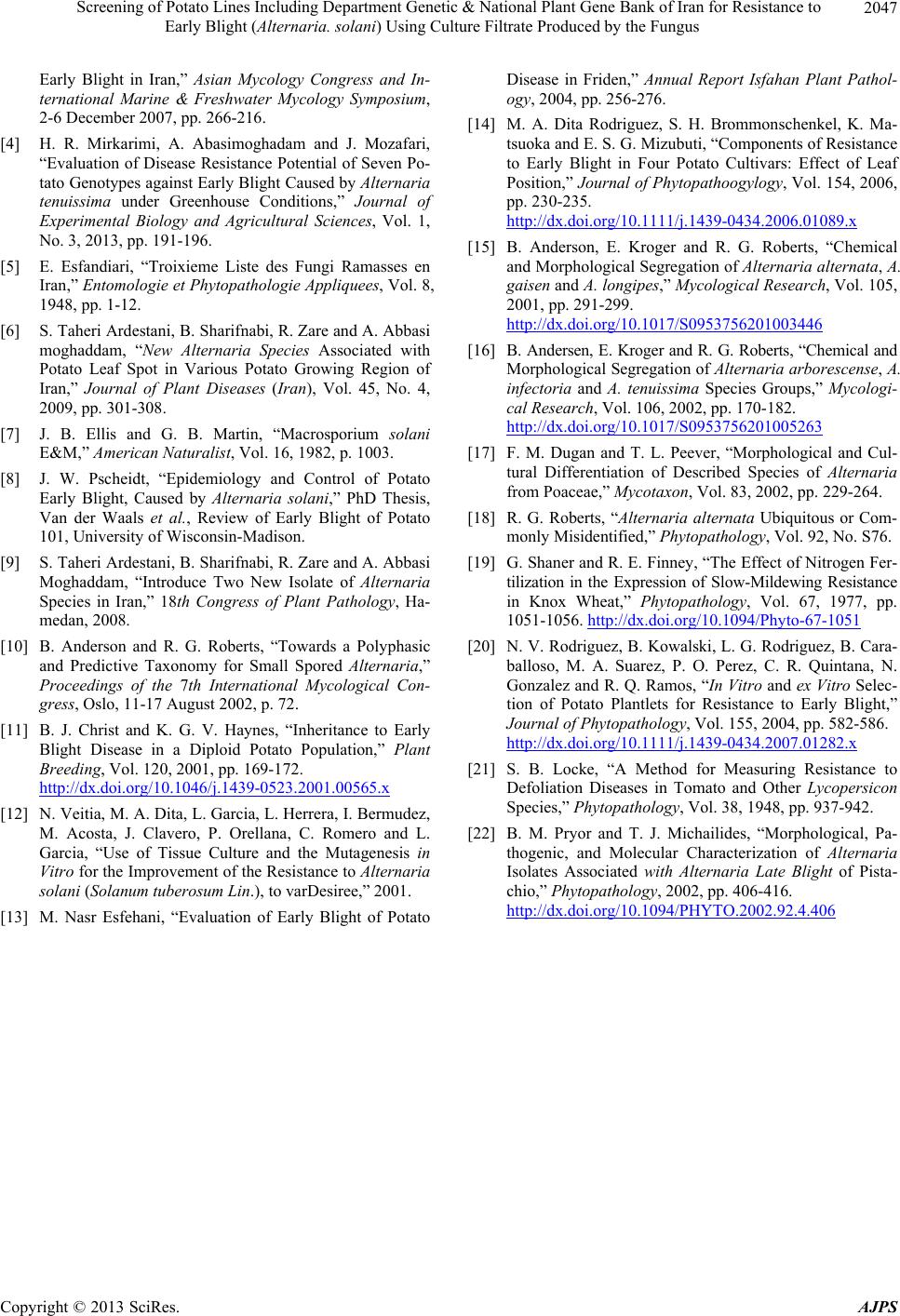
Screening of Potato Lines Including Department Genetic & National Plant Gene Bank of Iran for Resistance to
Early Blight (Alternaria. solani) Using Culture Filtrate Produced by the Fungus
Copyright © 2013 SciRes. AJPS
2047
Early Blight in Iran,” Asian Mycology Congress and In-
ternational Marine & Freshwater Mycology Symposium,
2-6 December 2007, pp. 266-216.
[4] H. R. Mirkarimi, A. Abasimoghadam and J. Mozafari,
“Evaluation of Disease Resistance Potential of Seven Po-
tato Genotypes against Early Blight Caused by Alternaria
tenuissima under Greenhouse Conditions,” Journal of
Experimental Biology and Agricultural Sciences, Vol. 1,
No. 3, 2013, pp. 191-196.
[5] E. Esfandiari, “Troixieme Liste des Fungi Ramasses en
Iran,” Entomologie et Phytopathologie Appliquees, Vol. 8,
1948, pp. 1-12.
[6] S. Taheri Ardestani, B. Sharifnabi, R. Zare and A. Abbasi
moghaddam, “New Alternaria Species Associated with
Potato Leaf Spot in Various Potato Growing Region of
Iran,” Journal of Plant Diseases (Iran), Vol. 45, No. 4,
2009, pp. 301-308.
[7] J. B. Ellis and G. B. Martin, “Macrosporium solani
E&M,” American Naturalist, Vol. 16, 1982, p. 1003.
[8] J. W. Pscheidt, “Epidemiology and Control of Potato
Early Blight, Caused by Alternaria solani,” PhD Thesis,
Van der Waals et al., Review of Early Blight of Potato
101, University of Wisconsin-Madison.
[9] S. Taheri Ardestani, B. Sharifnabi, R. Zare and A. Abbasi
Moghaddam, “Introduce Two New Isolate of Alternaria
Species in Iran,” 18th Congress of Plant Pathology, Ha-
medan, 2008.
[10] B. Anderson and R. G. Roberts, “Towards a Polyphasic
and Predictive Taxonomy for Small Spored Alternaria,”
Proceedings of the 7th International Mycological Con-
gress, Oslo, 11-17 August 2002, p. 72.
[11] B. J. Christ and K. G. V. Haynes, “Inheritance to Early
Blight Disease in a Diploid Potato Population,” Plant
Breeding, Vol. 120, 2001, pp. 169-172.
http://dx.doi.org/10.1046/j.1439-0523.2001.00565.x
[12] N. Veitia, M. A. Dita, L. Garcia, L. Herrera, I. Bermudez,
M. Acosta, J. Clavero, P. Orellana, C. Romero and L.
Garcia, “Use of Tissue Culture and the Mutagenesis in
Vitro for the Improvement of the Resistance to Alternaria
solani (Solanum tuberosum Lin.), to varDesiree,” 2001.
[13] M. Nasr Esfehani, “Evaluation of Early Blight of Potato
Disease in Friden,” Annual Report Isfahan Plant Pathol-
ogy, 2004, pp. 256-276.
[14] M. A. Dita Rodriguez, S. H. Brommonschenkel, K. Ma-
tsuoka and E. S. G. Mizubuti, “Components of Resistance
to Early Blight in Four Potato Cultivars: Effect of Leaf
Position,” Journal of Phytopathoogylogy, Vol. 154, 2006,
pp. 230-235.
http://dx.doi.org/10.1111/j.1439-0434.2006.01089.x
[15] B. Anderson, E. Kroger and R. G. Roberts, “Chemical
and Morphological Segregation of Alternaria alternata, A.
gaisen and A. longipes,” Mycological Research, Vol. 105,
2001, pp. 291-299.
http://dx.doi.org/10.1017/S0953756201003446
[16] B. Andersen, E. Kroger and R. G. Roberts, “Chemical and
Morphological Segregation of Alternaria arborescense, A.
infectoria and A. tenuissima Species Groups,” Mycologi-
cal Research, Vol. 106, 2002, pp. 170-182.
http://dx.doi.org/10.1017/S0953756201005263
[17] F. M. Dugan and T. L. Peever, “Morphological and Cul-
tural Differentiation of Described Species of Alternaria
from Poaceae,” Mycotaxon, Vol. 83, 2002, pp. 229-264.
[18] R. G. Roberts, “Alternaria alternata Ubiquitous or Com-
monly Misidentified,” Phytopathology, Vol. 92, No. S76.
[19] G. Shaner and R. E. Finney, “The Effect of Nitrogen Fer-
tilization in the Expression of Slow-Mildewing Resistance
in Knox Wheat,” Phytopathology, Vol. 67, 1977, pp.
1051-1056. http://dx.doi.org/10.1094/Phyto-67-1051
[20] N. V. Rodriguez, B. Kowalski, L. G. Rodriguez, B. Cara-
balloso, M. A. Suarez, P. O. Perez, C. R. Quintana, N.
Gonzalez and R. Q. Ramos, “In Vitro and ex Vitro Selec-
tion of Potato Plantlets for Resistance to Early Blight,”
Journal of Phytopathology, Vol. 155, 2004, pp. 582-586.
http://dx.doi.org/10.1111/j.1439-0434.2007.01282.x
[21] S. B. Locke, “A Method for Measuring Resistance to
Defoliation Diseases in Tomato and Other Lycopersicon
Species,” Phytopathology, Vol. 38, 1948, pp. 937-942.
[22] B. M. Pryor and T. J. Michailides, “Morphological, Pa-
thogenic, and Molecular Characterization of Alternaria
Isolates Associated with Alternaria Late Blight of Pista-
chio,” Phytopathology, 2002, pp. 406-416.
http://dx.doi.org/10.1094/PHYTO.2002.92.4.406